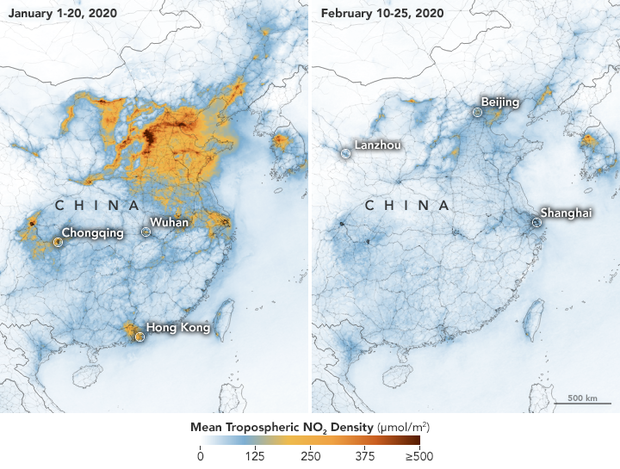5 things to know about climate change and coronavirus
Wednesday marks the 50th anniversary of Earth Day, and since well before the COVID-19 outbreak, the World Health Organization has been tracing and analyzing the impact of how climate change is impacting public health.
But as the global community continues to grapple with the coronavirus pandemic, top climate officials say our attention needs to shift to climate-related issues that directly impact our health.
In an interview with “Face the Nation” moderator Margaret Brennan, Dr. Diarmid Campbell-Lendrum, Head of the Climate Change and Health Program at the World Health Organization, says presently, air pollution “is one of the severest problems that we face around the world.”
Air pollution increases the risk of other illnesses like heart disease and respiratory issues, something that has had a direct impact on those suffering during the coronavirus outbreak. About one in eight deaths around the world are caused by air pollution.
Additionally, extreme weather events and increased temperature can all have negative effects on public health.
“The extreme weather events are getting more severe. So we’re seeing more severe heat waves. We’re seeing more severe wildfires,” Dr. Campbell-Lendrum said. “So it’s absolutely clear to us that climate change is making these extreme weather events worse, and it brings a whole range of severe impacts to human health.”
Dr. Campbell-Lendrum noted that while climate change did not cause coronavirus, “if we want to reduce the chances of the next pandemic, then we have to start taking more care of the natural environment.”
Here are five other things to know about how climate change is expected to impact public health worldwide:
- Air pollution kills 7 million people a year throughout the world
About 9 in 10 people around the world are inhaling polluted air. Air pollution is a contributing risk factor for many other illnesses such as heart disease and respiratory illness. According to the World Health Organization, a third of the deaths from strokes, lung cancer and heart disease are due to air pollution, and there is some evidence emerging out of the COVID-19 outbreak that suggests people living in areas with higher air pollution are more likely to be infected with the virus.
“We’re getting the first indications that places with high levels of air pollution may also have high rates of death and disease from COVID-19,” said Dr. Campbell-Lendrum. “It’s not conclusive at the moment, but it’s what we would expect and that’s what we think we’re starting to see.”
2. But air quality has largely improved due to the coronavirus outbreak
While the coronavirus has had devastating impacts around the globe, it has also led to a decrease in air pollution. In the northeastern United States, air pollution dropped by 30 percent in March, and countries like China and Italy have experienced similar decreases.
“We would never want to say this is okay, because the human cost of COVID-19 is so great,” said Dr. Campabell-Lendrum. “What we do want to make clear is that we should try and hang on to some of these gains as we come out of the COVID-19 crisis.”
3. 70 percent of the world’s infectious diseases have come from the natural environment, with many from animal-to-human contact
Most infectious diseases the world has had to deal with over the last few decades have come from the natural environment. “So it’s very clear that the damage that we’re doing to the natural world does make it more likely that these diseases will emerge,” said Dr. Campbell-Lendrum.
Evidence shows that COVID-19 was a zoonotic event that jumped from animal to humans. Many of the infectious diseases like SARS and even HIV were transmitted by animal to human contact, coming out of the natural environment.
“So when we damage the natural environment, when we overexploit it, and then when we don’t monitor what’s happening to infections in wildlife and infections in domestic animals and infections in humans, we’re basically leaving ourselves open to these-these risks,” said Dr. Campbell-Lendrum.
4. Climate change didn’t cause coronavirus — but it can help spread future pandemics and diseases
Dr. Campbell-Lendrum explained that while climate change isn’t directly correlated to the cause of coronavirus, “it’s very clear that the damage that we’re doing to the natural world does make it more likely that these diseases will emerge.”
Warming climates and increasing variability in weather patterns across the globe make it inherently easier to transmit diseases of any origin.
In order to reduce our chances for the next pandemic, Campbell-Lendrum says we need to start taking more care of our planet.
“Overall environmental damage seems to be increasing the risks either of past epidemics of this pandemic and potentially of future pandemics as well,” he said.
Campbell-Lendrum rightly noted that the COVID-19 crisis exposed our lack of preparedness for pandemics in general across the world. “In many cases we’ve gone in with weak health systems. In many cases we’ve gone in with a really high burden of environmental pollution, such as air pollution,” he said.
He added, “One of the things we’re saying is that we shouldn’t come out of this crisis in the same direction that we went in…We should be thinking, can we get-can we hang on to some of the environmental gains that we’re seeing in the COVID crisis, such as cleaner air.”
5. Adjusting our diet can be better for both you and the environment
Last year, the United Nations released a report saying that plant based diets are better for the environment. One of the reasons is that cows produce large amounts of the greenhouse gas methane when they eat. Additionally, eating large amounts of meat regularly, particularly processed meats, is not that healthy for humans.
“We’re not telling people they-they have to or they should become vegetarians,” said Dr. Campbell-Lendrum. “If you want to think about whether a more sustainable diet is going to be good for your health and good for the environment, now is a really good time to do it.”






Leave a Reply